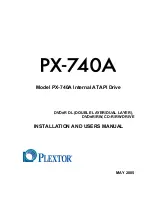
ROWAN ELETTRONICA s.r.l. - Via Ugo foscolo, 20 - 36030 CALDOGNO (Vicenza)
page 13 out of 24
APPLICATION DIAGRAMS
Connection diagram nr. 1
SPEED CONTROL IN BOTH ROTATIONAL WAYS WITH POTENTIOMETER
This type of operation foresees speed adjustment using an external potentiometer and selection of the rotational sense
with the forward run (TA) and backward run (TI) electromagnetic switches.
The optimum resistance of a potentiometer with 3-wire connection is 10Kohm, but it can assume values of between 2K
and 100K. In each case the minimum resistance applied to terminals 3 and 7 should not be less than 2Kohm (keep this
in mind if several potentiometers are used in parallel for speed switchover or to supply other potentiometers like those in
couple limitation). In the case of adjustment with 2-wire potentiometer, it can only be of 10Kohm. If speed adjustment is
carried out by an external 3-wire potentiometer and with the potentiometer cursor towards terminal 7 (0V), the motor
remains motionless. With the cursor towards terminal 3 (+10VDC), the motor revs. at the maximum speed set.
The emergency group with opening contacts includes: the current circuit breaker (TR) calibrated at 15% above the
nominal current of the motor – the circuit breaker sensor (ST) which reveals the temperature of the windings – the
emergency relay (RE).
The relay (RE) is normally active when the card is supplied and deactivates, together with the lighting up of pilot L4, in
case of irregularities due to: overload, lack of linear and motor phase, absence of tachometrical dynamo and inverted
tachometric polarity if the internal precision rectifying device is not used. When the RE drops, the electromagnetic switch
which supplies the card immediately disconnects. If the RE relay is not used for electromechanical detachment of the
supply to the card in a block situation, the lighting up of the L4 EMERGENCY pilot immediately blocks the motor with self-
maintaining functions from running. It can only be unblocked by removing supply from the card.
FOR THIS DIAGRAM THE MICROS ARE SET AS FOLLOWS:
S1 Open (turn adjustment with 3 wire potentiometer) / S1 closed (turn adjustment with 2 wire potentiometer)
S2 Choose the acceleration and deceleration ramp range (open 0.02 sec. – 2 sec. / closed 0.25 sec. – 25 sec.)
S3 Open if a 2-pole motor is being used / S3 Closed if a 4 – 6-pole motor is being used.
With 6-pole motors, the maximum speed should be recalibrated using the P3 trimmer
With the turn adjustment potentiometer at maximum, adjust P3 in an anticlockwise direction until the tachometrical
dynamo measures a continuous voltage of approx. 5.7VDC, which corresponds to a maximum speed of 800r/m.
S4 Open – S5 Closed (tachometric rectifier inserted)
S6 Closed – S7 Open (proportional gain with maximum error 15 r/m)
S8 Closed – S9 Open (couple limitation closed)
S10 Open (dc braking inserted) / S11 Open (inputs for PNP logic) / S12 Closed (speed adjustment from potentiometer)










































